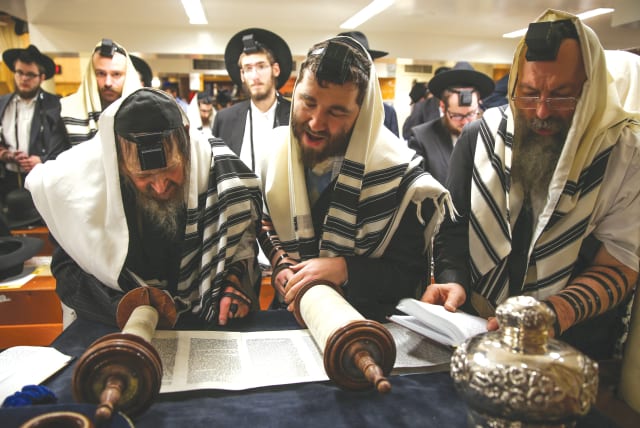The history and evolving tradition of Shavuot - opinion

Shavuot’s journey from an agricultural celebration to commemorating the Giving of the Torah, and its eventual return to an agricultural focus, underscores the adaptability of Jewish tradition.
The festival of Shavuot is almost upon us, a time steeped in both tradition and innovation. Shavuot, a Torah-commanded festival, offers a fascinating study in the inventive genius of the rabbis and the evolving yet cyclical nature of the Jewish people. The Torah designates Shavuot with four distinct names: Shavuot (the Feast of Weeks), Chag Hakatzir (the Harvest Festival), Chag Habikkurim (the Festival of First Fruits), and Atzeret (the end of the period between Passover and Shavuot).
Each of these names emphasizes the agricultural essence of the holiday. During the Temple era, Jewish farmers would bring their first fruits, presenting them to the Kohen (priest) amid great fanfare, in beautifully woven baskets or on silver platters.
A unique offering during Shavuot was the presentation of two loaves of bread baked from the newly harvested wheat, which had just ripened at this time of year. The festival allowed the farmer to express gratitude to the Almighty for the bounty of the Land of Israel and the privilege of cultivating food from the Holy Land.
Interestingly, nowhere in the Torah does it explicitly mention that Shavuot commemorates the giving of the Torah. Yet, if you ask any Jewish kindergarten child about the significance of Shavuot, they will eagerly tell you it is the day the Jewish People received the Torah on Mount Sinai. Why is this the case?
In 70 CE, the Temple was destroyed by the Romans, and the people of Israel were exiled from their Land. This exile meant the cessation of the agricultural practices that were central to Shavuot. Without Jewish farmers or a Temple to bring offerings to, Shavuot had seemingly lost its anchor.
Passover had the Seder, matzot, and the ritual of clearing out hametz; Succot had its unique outdoor booths and the waving of the four species. Shavuot, on the other hand, appeared to lack a distinctive ritual to keep it relevant.
A new focus for Shavuot
The rabbis, understanding the necessity of maintaining the holiday’s significance, found a new focus for Shavuot. Although the actual day of the giving of the Torah was the day after Shavuot, on the 7th of Sivan, it was close enough. Over the centuries, Shavuot became known as Zman Matan Torateinu, the Time of the Giving of the Torah. This new focus was universally relatable, especially in exile, whereas the agricultural aspects had become less relevant due to the Jewish people’s displacement.
Fast forward nearly 1900 years to the return to Zion with the First and Second Aliyah movements, which emphasized reclaiming the land and fostering agricultural development. The kibbutz movement, initially entirely agricultural in nature, brought Shavuot full circle. Generally speaking, these early Zionist pioneers were not religiously observant, having largely abandoned the mantle of Torah observance. For them, the time of the Giving of the Torah held little relevance. However, the agricultural significance of Shavuot became profoundly important once again, restoring Shavuot to its original place as a central agricultural festival.
In modern Israel, which ideally merges agricultural, cultural, and religious aspects of Judaism, Shavuot is celebrated in diverse ways. Those for whom the Torah is central, the holiday is marked with extra learning, including the all-night study session known as Tikkun Leil Shavuot. Those to whom the land is central, the holiday is marked with special fruits and foods, celebrating and giving thanks for the bounty of the Land of Israel.
As we approach this multifaceted festival, we reflect on its rich history and evolving significance. Shavuot’s journey from an agricultural celebration to a commemoration of the Giving of the Torah, and its eventual return to an agricultural focus in the modern era, underscores the resilience and adaptability of Jewish tradition. The rabbis’ ability to reinterpret and reframe the festival ensured its survival and relevance through centuries of change and upheaval.
Today, Shavuot stands as a testament to the enduring connection between the Jewish people and their land, their history, and their Torah. It serves as a reminder of the importance of gratitude, learning, and community. Whether through the study of Torah or the celebration of the land’s bounty, Shavuot offers a time for reflection, thanksgiving, and joy.
As we celebrate Shavuot, we also recognize the importance of unity and peace. The festival encourages us to come together, despite our diverse ways of observing and understanding it. In the spirit of Shavuot, we pray for a Chag Sameach – a joyous, safe, and peaceful holiday for all. May this Shavuot bring us closer to our traditions, to our land, and to one another, as we continue to cherish and celebrate the rich tapestry of Jewish life.
The writer is a rabbi and physician who lives in Ramat Poleg, Netanya, and is cofounder of Techelet-Inspiring Judaism.
Jerusalem Post Store
`; document.getElementById("linkPremium").innerHTML = cont; var divWithLink = document.getElementById("premium-link"); if (divWithLink !== null && divWithLink !== 'undefined') { divWithLink.style.border = "solid 1px #cb0f3e"; divWithLink.style.textAlign = "center"; divWithLink.style.marginBottom = "15px"; divWithLink.style.marginTop = "15px"; divWithLink.style.width = "100%"; divWithLink.style.backgroundColor = "#122952"; divWithLink.style.color = "#ffffff"; divWithLink.style.lineHeight = "1.5"; } } (function (v, i) { });

